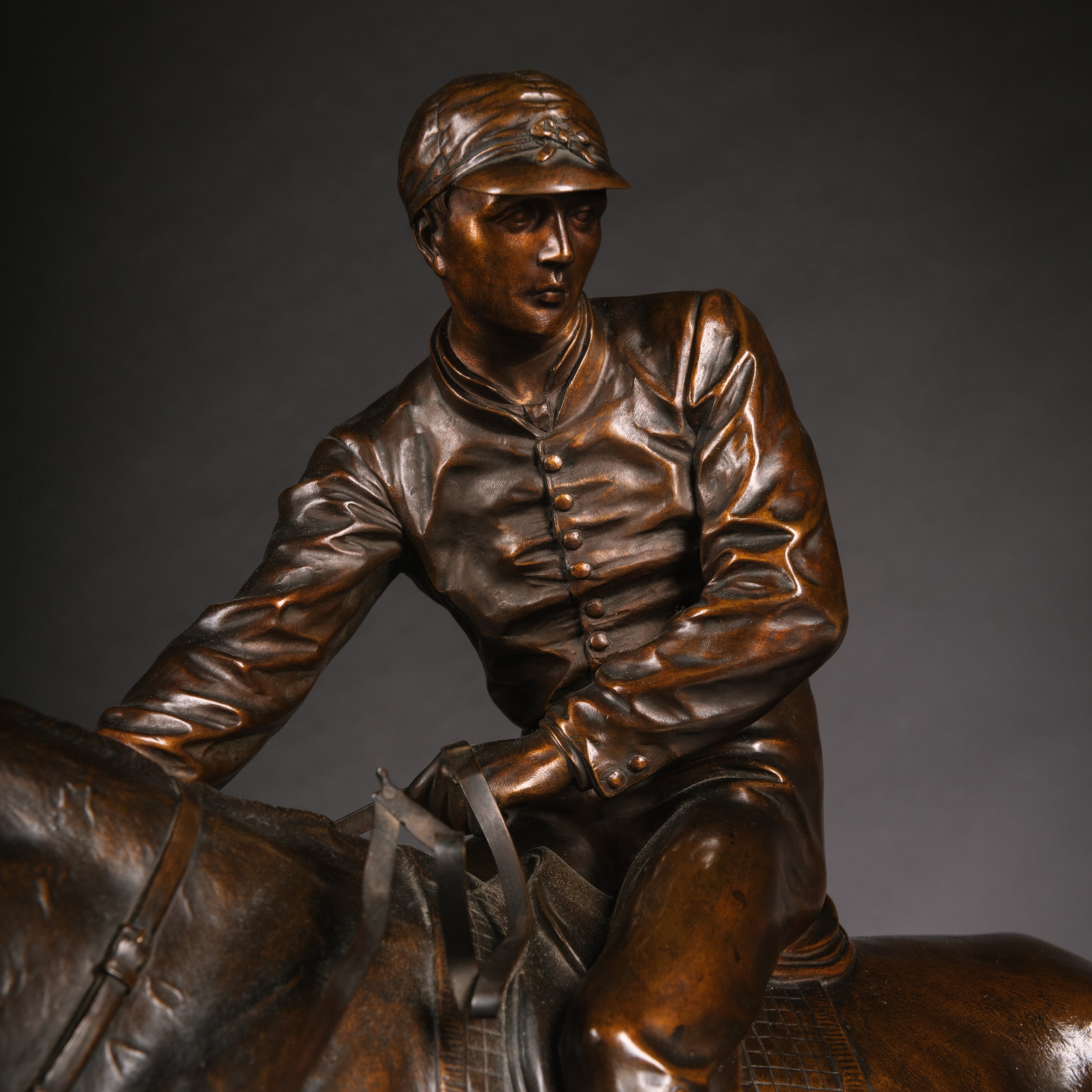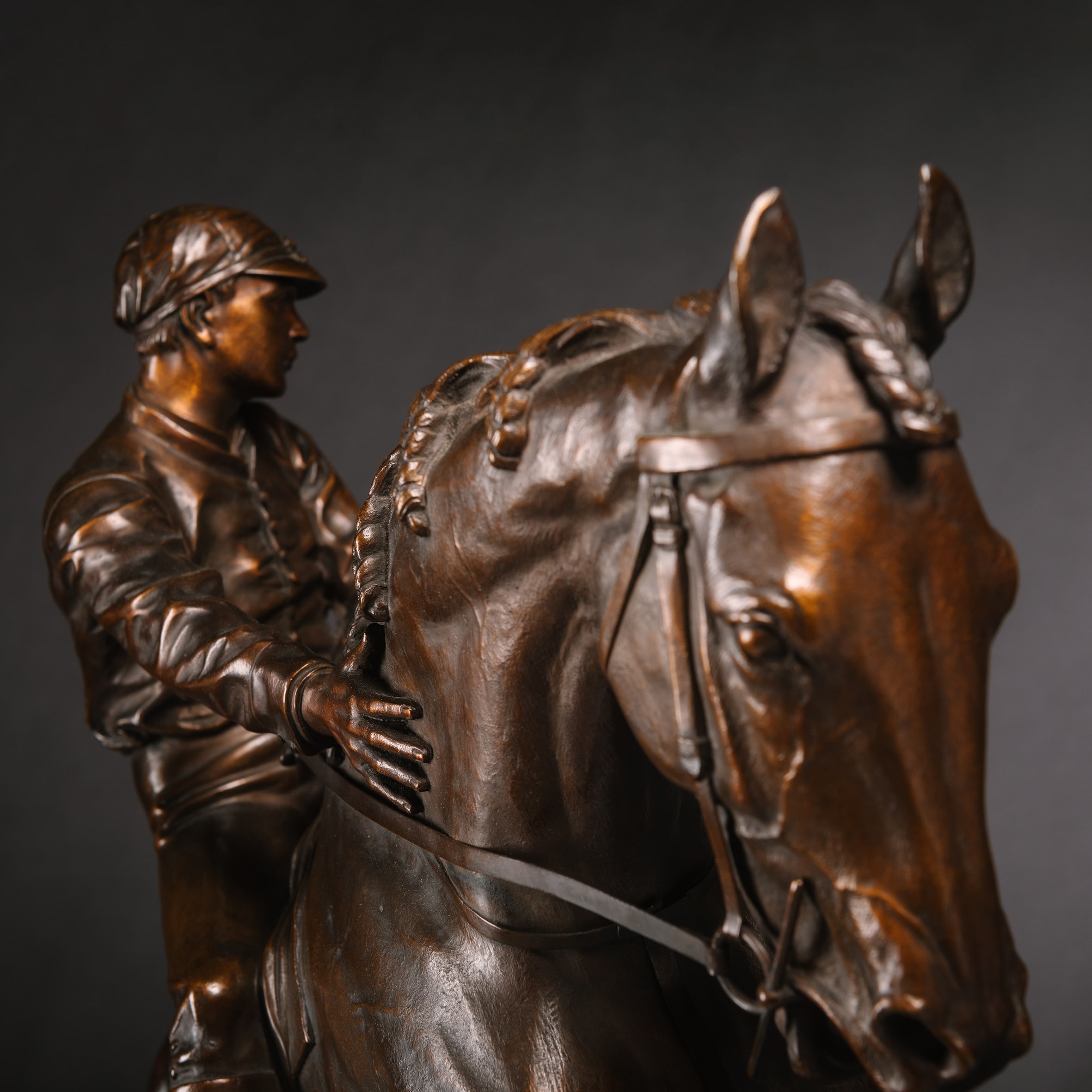Isidore-Jules Bonheur (French,1827-1901)
Isidore Jules Bonheur (FRENCH, 1827-1901) ‘Le Grand Jockey ‘
£85,000
Isidore Jules Bonheur (FRENCH, 1827-1901) ‘Le Grand Jockey ‘ Signed 'I Bonheur' and with foundry stamp PEYROL EDITEUR'. Bronze, rich mid-brown...
Dimensions
Height: 62 cm (25 in)Width: 75 cm (30 in)
Depth: 16 cm (7 in)
Description
Isidore Jules Bonheur (FRENCH, 1827-1901)
‘Le Grand Jockey ‘
Signed ‘I Bonheur’ and with foundry stamp PEYROL EDITEUR’.
Bronze, rich mid-brown patina.
The name Isidore-Jules Bonheur is synonymous with the great animalier school of sculptors of the late 19th century. Amongst Bonheur’s wide variety of animal sculptures exhibited at the Salon, there were a number of mounted equestrian models, including three designs of jockeys on horseback shown in 1864, 1879 and 1886. The most famous of these is Le Grand Jockey, of which the present cast is a rare, large, and fine example.
It shows a victorious jockey patting his horse on the neck in congratulation, perfectly chiseled especially with precision work for the veins, tendons and muscles, as well as the rider’s jacket and the horse’s mane. First exhibited at the 1879 Salon in bronze, under the title ‘Un Jockey’, it was displayed alongside another equestrian group, Un cavalier, époque de Louis XV (nos. 4817 and 4816 respectively). Exhibited again four years later at the Exposition Nationale des Beaux-Arts in 1883 and for the third time at the Universal Exhibition of 1889, where Bonheur received the prestigious Medaille d’Or. Le Grand Jockey was subsequently edited in four different sizes, the present cast being an example of the second largest.
Son of the painter Raymond Bonheur and brother of Rosa Bonheur, Isidore Bonheur was born in 1827 in Bordeaux and trained with his father. He exhibited in 1848 for the first time at the Salon des Artistes Français and entered the School of Fine Arts in Paris where he turned his attention to sculpture.
Bonheur had a close working relationship with his brother-in-law, the celebrated Parisian founder Hippolyte Peyrol, who was married to his sister Juliette (1830-1891). These close ties resulted in the production of exceptionally cast and finely chased bronzes, often identified, as here, by Peyrol’s tiny cachet. Peyrol was a master caster and his foundry in Paris is rightly considered one of the finest of the period.
France, Circa 1890.
Date
Circa 1890
Origin
France
Medium
Bronze
Signature
Signed 'I Bonheur' and with foundry stamp PEYROL EDITEUR'.
Isidore-Jules Bonheur (1827-1901) was the son of the painter Raymond Bonheur and younger brother of Rosa Bonheur, the famous sculptor. He was born in Bordeaux and studied painting, at first with his father and then with the Ecole des Beaux Arts in Paris, moving on to sculpture in 1848.
He made his debut at the Paris Salon in 1848 with a painting and plaster study of the same subject ‚‘African horseman attacked by a lioness‚’. From then onwards, Bonheur exhibited regularly at the Salon as well as other exhibitions, winning medals in 1865 and 1869 together with the prized Gold Medal at the Exposition Universelle of 1889.
He was awarded the Legion d‚’Honneur in 1895.
Most of Bonheur’s casts were by his uncle by marriage, Hippolyte Peyrol, whose tiny foundry mark is often very difficult to find.
Bonheur’s studies range from farm animals, bears and tigers in a very naturalistic vein to equestrian groups. Although noted primarily for his small groups he did complete two large scale commissions, one to his sister Rosa, at Fontainbleau and the other, two stone lions at the steps of the Royal Palais de Justice, Paris. Bonheur became part of the group of animal sculptors of the late nineteenth century known as ‚‘Les Animaliers‚’
Working in a realistic manner, Bonheur was an acute observer of nature – his animals were not ‚‘humanised‚’ but modelled to catch a pose characteristic of the particular species. He achieved this particularly well with his sculptures of horses, which, usually more relaxed than spirited, are among his most successful works.
Literature
Jane Horswell, Bronze Sculptures of ‚‘Les Animaliers‚’ , p201
Pierre Kjellberg, Les Bronzes du XIX Siècle, p101
S. Lami, ‘Dictionnaire des sculpteurs de l’école française du XIXe siècle’, vol. 1, Paris, 1916, pp.127-130; J. Horswell, ‘Les Animaliers’, Woodbridge, 1971, p. 209; M. Forrest, Art Bronzes, Pennsylvania, 1988, p. 227.
M. Forrest, ‘Art Bronzes’, Pennsylvania, 1988, p. 227.
Pierre Kjellberg, ‘Les Bronzes du XIX e siècle’, Dictionnaire
des Sculpteurs, Paris 1987, l’Amateur Ed. Pages 102 et 103.















 Print
Print


